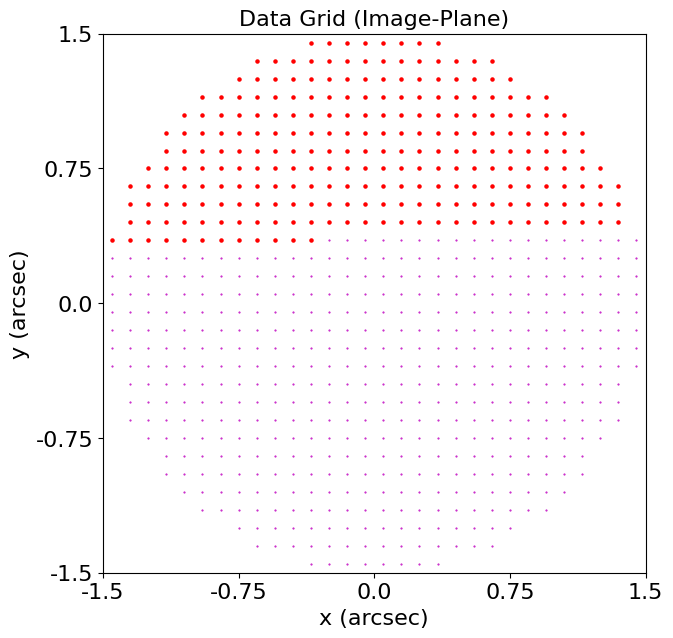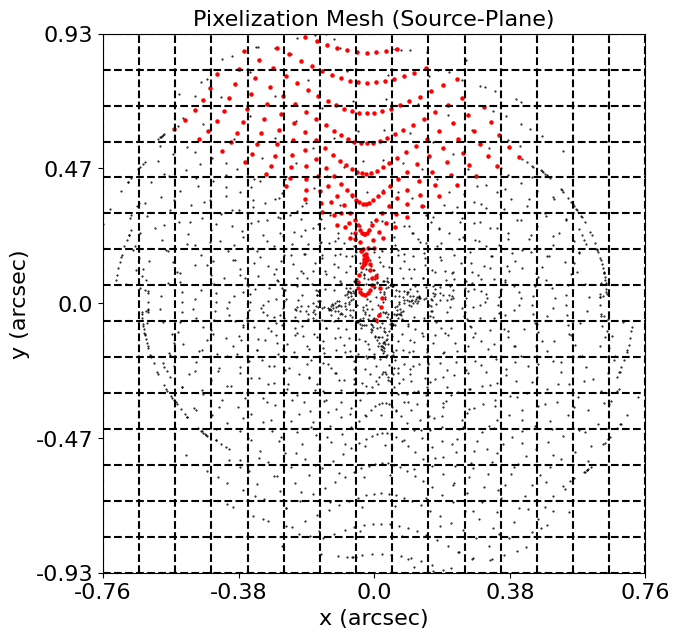autolens.Pixelization#
- class Pixelization[source]#
Bases:
objectPairs a 2D grid of (y,x) coordinates with a 2D mesh, which can be combined with a
Regularizationscheme in order to reconstruct data via anInversion.Image-Plane Example
For the simplest case, we have a 2D image whose pixel centres are defined on a (y,x) grid of Cartesian coordinates, which are paired with the
Meshof thePixelization:


The visual above shows:
Left: Observed image of a galaxy.
Centre: The (y,x) grid of coordinates corresponding to the centre of each pixel in the observed image. The centre of each pixel is shown by a magenta point.
Right: An overlaid
Rectangularmesh, where the square pixel boundaries of this mesh are shown by dashed black lines.
Red points highlight a subset of points. They are used below to illustrate additional behaviour of
Pixelization’s.The centre and right panels show the core functionality of a
Pixelization. It represents the mappings between an image’s (y,x) grid of coordinates and aMesh’s (y,x) grid of coordinates (in the example above the centres ofRectangularpixels, shown by the dashed black lines).Image-Plane Example (Masked)
The mappings above are shown for a 2D image which was not been masked.
The images below use the same image, which has had a 2.5” circular mask applied to it:



The behaviour is analogous to the non-masked case, however only unmasked pixel’s in the image’s (y,x) grid of coordinates are included when pairing with the
Rectangularmesh.Source-Plane Example (Masked)
In PyAutoGalaxy the above two cases are representative of how
Pixelizationobjects are used.In the strong lensing package PyAutoLens, gravitational lensing deflects the observed image’s (y,x) grid of coordinates and the
meshis overlaid in the source-plane:


The red points, highlighted throughout all visuals above, show that after gravitational lensing the points change position from the image-plane to source-plane.
Pixelization Uses
The following objects / packages are used with a
Pixelization:Mapper: Computes the mappings between the image’s (y,x) grid and the mesh’s pixels.Inversion: Use thePixelizationto reconstruct the data on the mesh via linear algebra.Regularization: Apply smoothing to the solutions computed using anInversion.
In the example above, a
RectangularMeshobject is used. Other meshes are available (e.g.Delaunay,Voronoi).Source Code API
The
PixelizationAPI uses the following terms for the grids shown above:image_plane_data_grid: The observed data grid in the image-plane (which is paired with the mesh).image_plane_mesh_grid: The (y,x) centers of the mesh pixels in the image-plane.source_plane_data_grid: The observed data grid mapped to the source-plane after gravitational lensing.source_plane_mesh_grid: The (y,x) centers of the mesh pixels mapped to the source-plane after gravitational lensing.
If a transformation of coordinates is not applied (e.g. no gravitational lensing), the
image_planeandsource_planegrids are identical (this is the case in PyAutoGalaxy).- Parameters:
mesh (
AbstractMesh) – The mesh object (e.g. Rectangular grid of pixels, Delaunay triangulation, Voronoi mesh) describing the pixels of the Pixelization.regularization (
Optional[AbstractRegularization]) – The regularization object that can smoothPixelizationpixels with one another when it is used to reconstruct data via an Inversion.image_mesh (
Optional[AbstractImageMesh]) – The grid of mesh coordinates may be derived from the image, for example if the pixelization is adaptive. This object controls how this mesh is computed.
Examples
import autogalaxy as ag grid_2d = al.Grid2D.uniform(shape_native=(50, 50), pixel_scales=0.1) mesh = al.mesh.Rectangular(shape=(10, 10)) pixelization = al.Pixelization(mesh=mesh)
# The example below shows how a `Pixelization` is used in modeling. import autofit as af import autogalaxy as ag mesh = af.Model(ag.mesh.Rectangular) mesh.shape_0 = af.UniformPrior(lower_limit=10, upper_limit=20) mesh.shape_1 = af.UniformPrior(lower_limit=10, upper_limit=20) pixelization = af.Model( ag.Pixelization, mesh=mesh regularization=ag.reg.Constant ) galaxy = af.Model(ag.Galaxy, redshift=0.5, pixelization=pixelization) model = af.Collection(galaxies=af.Collection(galaxy=galaxy))
Methods
Attributes
Returns a
MapperGridsobject, which contains all of the different grids used by a pixelization (image_plane_data_grid,image_plane_mesh_grid,source_plane_data_grid,source_plane_mesh_grid).